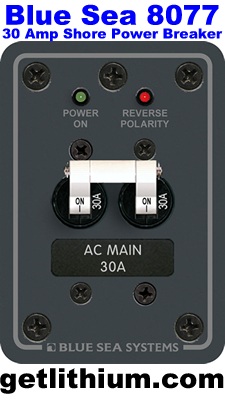We
worked on this project in 2022 at our Langley
workshop. The challenge on this project was that
the factory under the step battery compartment
was much shorter than most that we have worked
on and was not going to give us enough vertical
height to locate the new Lithionics
GTX Series 12 Volt 320 Amp hour lithium-ion battery
in there. So after consulting with the Owner,
we decided to cut out the bottom panel of the
existing battery compartment, fabricate some new
sheet metal battery compartment extensions and
fasten this in place to give us an additional
3 1/4" of vertical height. Some of the photos
below show this fabrication work being done.

As
with almost all of these similar Class B motorhomes,
in addition to the great high performance Lithionics
battery that almost triples their house battery
capacity over the original AGM batteries, we also
installed a Xantrex
Freedom XC Pro 3,000 Watt inverter-charger
to replace the existing 2,000 Watt Xantrex model.
This is done so that we can rewire the 120 Volt
AC breaker box and give the Owner the ability
to even run the air conditioner from battery power.
One of these Lithionics batteries can run most
air conditioners for a good 3 or 4 hours.
On
this project the Client wanted more than the 30
Amps of lithium-ion battery charging via the alternator
than offered by the 30 Amp Victron Orion DC to
DC charger so we installed the 50 Amp output Kisae
brand DC to DC battery charger - its also approved
for use by Lithionics Battery.
Also
a part of every one of these Lithionics 320 Amp
hour internal BMS battery installations is the
addition of two Blue
Sea Systems 350 constant Amp marine rated battery
disconnect switches (one connects between
the battery positive terminal and the positive
bus bar and the other connects on the inverter's
positive line between the Class T fuse and the
inverter's positive connection post), a 300
Amp MRBF fuse on the battery's positive battery
post (we bump this up to a 400 Amp ANL fuse assembly
when using two Lithionics batteries), a 250
Amp Class T fuse assembly for the inverter-charger
(we bump this up to 350 Amps when using two Lithionics
batteries) as well as tinned
copper marine rated bus bars.
When
the RV is factory equipped with what we call a
"split panel" 120 Volt AC circuit breaker
panel we can in most cases rewire it so that instead
of the incoming shore or generator 120 VAC power
going straight to the circuit breaker box, we
instead wire it to the inverter-charger's 120
VAC input. We then wire the inverter's 120 VAC
output to the 30 Amp main circuit breaker panel.
As long as there is 10 AWG 120 VAC factory wiring
we can normally do this pretty quickly without
having to upgrade the 120 VAC wiring. In the split
panel breaker box we then reposition several of
the circuit breakers.
How
do I tell if my RV has the split panel circuit
breaker box?
Simply turn off all power in the RV and remove
the 120 VAC circuit breaker panel's fron cover(s).
Look inside and if you see white wires going to
two separate metal bolting strips, then you have
a split panel circuit breaker box.
If
you do not have a split panel 120 VAC breaker
box, we can still rewire the system so that we
can have everything run from the battery system.
However, we will need to add a new 30 Amp shore
power circuit breaker by Blue Sea Systems as shown
below:

This
will add anywhere from 2 to 4 hours of installation
time.
Feel
free to browse through some of the installation
photos below:

